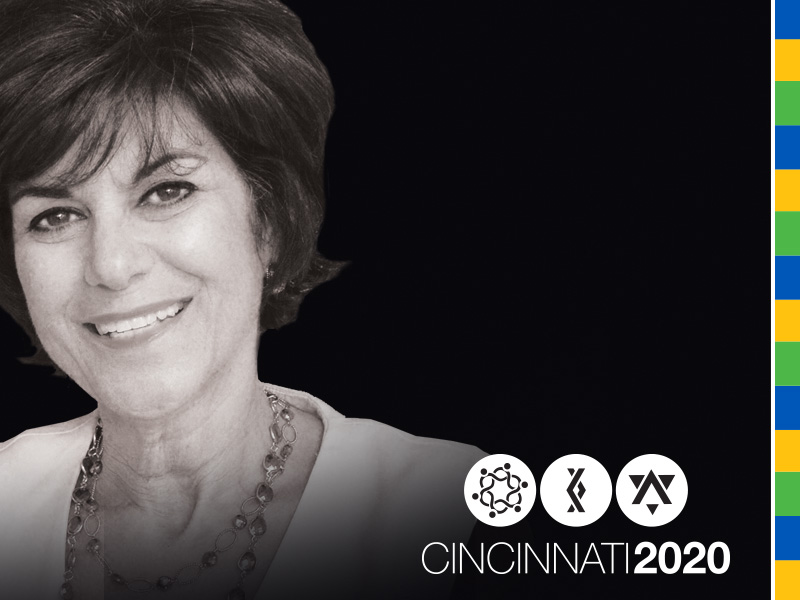Danielle V. Minson — Raising the Bar

Cincinnati 2020 in 2016: Leslie Newman: By Barb Miller & Tedd Friedman
This guest post series is to let you know a bit more about Cincinnati 2020, our community’s collaboration to build an engaged and empowered Jewish community by the year 2020. This week, our Director of Community Building at the Federation, Barb Miller, and the chair of Cincinnati 2020, Tedd Friedman, talk with Leslie Newman, Trustee and Treasurer of The Jewish Foundation of Cincinnati.
How did you first get involved in Cincinnati 2020?
Because of my role with The Foundation, I do have somewhat of an “insider’s lens” into Cincinnati 2020’s process and objectives. And I would tell people that, even though the Federation and Foundation are autonomous, independent organizations, we work together very closely with many similar goals. We have all worked hard to build a cohesive, united community and I think that is something to be incredibly proud of. So, essentially, The Foundation’s goals are very closely aligned with the goals of 2020.
What will Cincinnati 2020 do for seniors?
The seniors of the 21st century will face healthcare, housing, vocational, and financial challenges different than those of prior generations. Cincinnati 2020 has highlighted the importance of self-sufficiency and growing old gracefully. 2020’s goal is for 90% of Jewish clients over 65 to have the support needed to live independently and report a high quality of life.
How did the Senior Services Working Group come to be?
Several years ago, the executives of organizations that were already providing senior services in our community (Jewish Family Services, JVS Career Services, Cedar Village, and the Mayerson JCC) came together with representatives of the Federation and Foundation and formed the Senior Services Working Group to address the needs of the fastest growing demographic in our community. These agencies were already doing, and continue to do, extraordinary work in the field benefiting so many individuals in our community. We were excited about the possibility to build on that great work and leverage new resources to help make Cincinnati the best Jewish community in the country in which to grow older. So we did quite a bit of research, looked at innovative programs that were going on in other cities, and identified a number of needs in Cincinnati.
Any hints about what’s in the works?
Our first senior initiative to be launched later this year is an Information and Referral Access Point. So often, seniors (or their children or caretakers) don’t know how to find information about aging services in our community. With this information and referral system, there will be one central phone number to call as well as a website for anyone who has these types of questions. We also plan to install kiosks at the Mayerson JCC and other locations around the community. We’re exploring other initiatives, too, such as expanding transportation and enhancing quality of life for “Active Boomers.”
What does the future of senior services in Jewish Cincinnati look like?
People are living longer. We as a community need to address the many issues that come with aging. Many have not planned properly for retirement. Some need help with financial literacy. Others have no children or family in town for support. There is need for affordable senior housing. Our Working Group understands that the needs are great and resources, of course, are finite. But it is encouraging to know that we as a community are facing these challenges together, which makes the future full of exciting possibilities. In a more global context, what I ultimately hope for is that individuals living here will feel a strengthened community that nurtures its citizens and helps enhance their well-being. And through the collaboration that Cincinnati 2020 is fostering, I think we can get there.
As someone with that “inside lens,” do you think Cincinnati 2020 has been successful?
I have been involved in our Jewish community since I moved to Cincinnati more than 30 years ago. At that time, our synagogues, temples, agencies, and organizations were more singular with regard to the way they functioned. What is different and striking now is the way that individuals as well as organizations willingly collaborate with one another. The bold message that 2020 sends is, “we are all part of one community and we all have equal responsibility and opportunity to come together, dream, and make this a stellar place to live.” That is a very empowering charge. So yes, I would say that 2020 is already successful in that it has allowed so many people to have a part in shaping our community’s future.
Did anything about the Cincinnati 2020 collaboration surprise you?
I remember sitting in the first Cincinnati 2020 meeting five or six years ago, wondering how so many people with different agendas could come together and formulate any kind of meaningful strategic plan. But here we are, halfway through the process and as many, if not more, people continue to be involved and engaged. And what has come out of this endeavor is an actual working document that is being used to guide our community today and into the future. Congress should take a lesson!

